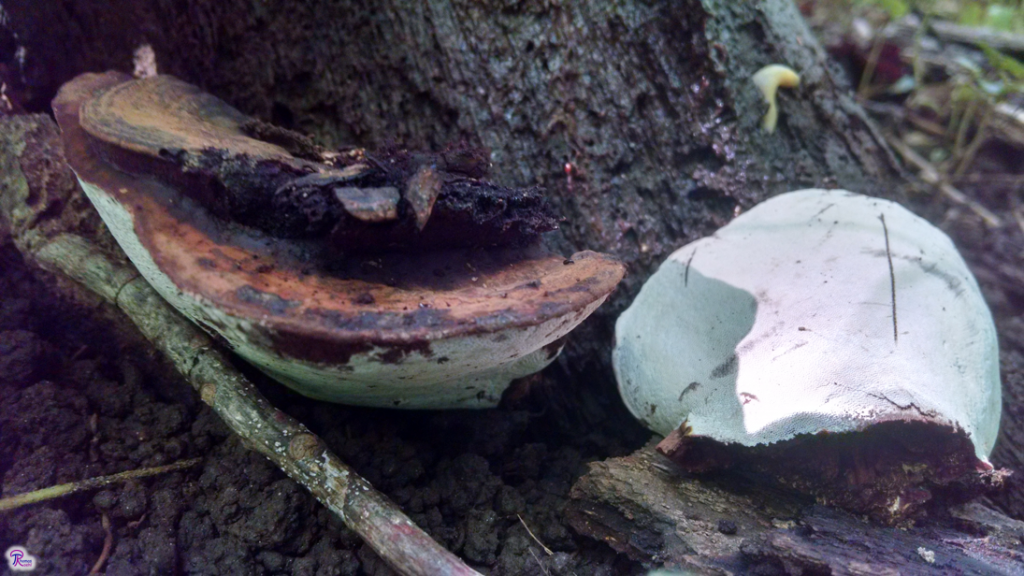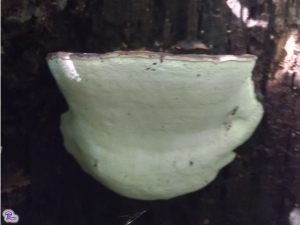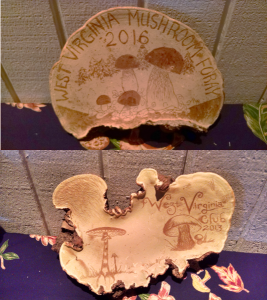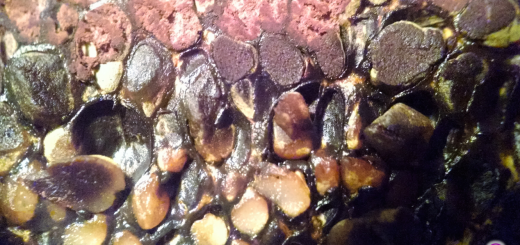#070: Ganoderma applanatum, The Artist’s Conk

Ganoderma applanatum is known as the “Artist’s Conk” because its white pore surface stains instantly brown when injured. The mushroom on the right was gently scratched to demonstrate this reaction.
Ganoderma applanatum is unique among fungi in that it is primarily used by humans as an artistic medium. This large, woody bracket fungus features a mostly flat white pore surface that immediately stains brown when handled. Because of this, the mushroom readily becomes a natural canvas for an artist. By lightly scratching the pore surface, an artist can produce beautiful sketches without using a pen, pencil, or paint. The pores stop growing once the mushroom is removed from its substrate, so the stains remain on the pore surface. Conks produced by G. applanatum are woody and therefore decay very slowly. As a result, artwork produced on the Artist’s Conk can last for many years when dried and kept indoors.1,2
Description
Ganoderma applanatum forms large conks, which are fan-shaped polypore mushrooms that grow shelf-like from dead logs. Conks are also known as bracket mushrooms or shelf mushrooms. The conks produced by G. applanatum can be up to 75cm across, though average specimens are much smaller. G. applanatum forms perennial fruiting bodies, which allows the conks to get bigger every year. The new pore surface forms on the bottom of the conk, so you can tell how old the mushroom is by slicing it in half and counting the pore layers.2–5
Aside from its large size, Ganoderma applanatum is rather unimpressive in nature. Its pileus surface is mostly flat, matte brown, lumpy, and usually zonate. Underneath, the mushroom is smooth, bright white, and features tiny pores (4-6 per millimeter). G. applanatum is usually thicker in the middle and thinner at the sides, making the lower surface somewhat curved. The most interesting feature of the mushroom is that the pore surface instantly turns brown where it is touched.2–5
Sometimes a standing tree being decayed by G. applanatum falls to the ground. This causes the conks to become deformed. The mushrooms always want to grow parallel to the ground because that allows them to drop spores into air currents. When a tree falls down, the mushroom ends up perpendicular to the ground. Any spores released will fall to the bottom of the cylindrical pores and remain inside the mushroom. To solve this problem, the fungus produces many, tiny conks on the surface of the misaligned conk. This “adventitious fruiting” makes the mushroom look very strange, but aligns the pore surface so that spores can be successfully released.3
The Artist’s Conk produces brown to reddish brown spores.2,4,5 It is a prolific spore producer, so nearby surfaces are often completely coated with brown dust.4 Microscopically, the elliptic spores can be seen to have two walls with darker columns between the walls.2 These unusual spores are unique to the genus Ganoderma.6
Ecology
The Artist’s Conk is common and widely distributed in the Northern Hemisphere.2,5 G. applanatum is not very picky about its habitat; it grows year-round on logs and stumps of hardwood trees and sometimes conifers.2–5 It produces spores in the summer and fall, so most of the mushroom’s growth happens during that time.5 Although G. applanatum is primarily saprobic, it is occasionally found growing parasitically on injured but living trees.2–5 The fungus causes a white rot and attacks both the heartwood and sapwood, making it particularly destructive if it does get into a living tree.2
The Artist’s Conk plays host to a rather unusual insect: the Yellow Flat-Footed Fly, Agathomyia wankowiczii. The Yellow Flat-Footed Fly is unique in its ability to form galls on a fungus and specifically targets G. applanatum.5,7 A. wankowiczii lays its eggs on the pore surface of the Artist’s Conk, where the larval flies stimulate the fungus to produce galls: cylindrical to conical growths on the pore surface that protect the developing fly. The larva feeds on the fungus but does not cause any damage outside the gall. When the larva is ready to metamorphose from a child to an adolescent, it burrows out of the gall and falls to the ground. It pupates in the soil and eventually emerges as an adult fly. The range of the Yellow Flat-Footed Fly is limited to Europe and parts of northern Asia, so don’t expect to find galls on G. applanatum anywhere else in the world.7,8
Similar Species
There are numerous Ganoderma species that look nearly identical to G. applanatum. However, none of these show the remarkable staining ability of the Artist’s Conk.4 Quickly scratching the pore surface will tell you whether you found G. applanatum, but unfortunately won’t get you very far in identifying what other species of Ganoderma you did find.
Uses and Edibility
Humans have found a number of uses for G. applanatum. The most important of these is as an artistic medium. People who aren’t good at sketching (such as myself) normally just scratch a happy stick figure into the pore surface. However, give it to an artist and the result can be unbelievable.1–5,9 Just do an image search for “Artist’s Conk” and you’ll see what I mean.
The rapidly-bruising pore surface is also frequently used by people to send notes to their fellow mushroom hunters. This can be done a couple of ways. One is to scratch a note on the pore surface and leave the mushroom on the tree. The still-growing mushroom will eventually erase the note and provide a new, blank canvas. Another way is to remove it from the tree, write an address on it, add some stamps, and mail it from the nearest Post Office. Believe it or not, the USPS will deliver the conk to its intended recipient (note: I have not tried this myself).10
Because the fungus bruises so easily, it’s actually very difficult to remove the conk without smudging the pore surface a little. You can’t touch the pore surface without leaving fingerprints, but you also can’t let it fall on the ground without your canvas getting scratched up.9 I haven’t come up with a great method for removing the fungus with the pore surface in pristine condition, so just do your best. If you do collect some G. applanatum, please remove as little as possible. Remember, mushrooms are living things and serve an important role in the propagation of fungi.
Some people use the Artist’s Conk for its medicinal benefits. All Ganoderma species are considered to have basically the same health benefits. Traditional Chinese medicine considers Ganoderma species (especially G. lucidum) a panacea, with the ability to cure everything from mild infections to chronic diseases.1 Because of its woody texture, G. applanatum is inedible in its natural state.3 Instead of eating the mushroom whole, it must be dried, ground into small pieces, and made into a tea or tincture.9
Taxonomy
G. applanatum is placed in the order Polyporales, demonstrating its relationship to the core group of polypores11. The genus name Ganoderma means “shiny or lustrous skin,” which is typical of other members of the genus such as G. lucidum.1,3 Despite its genus name, G. applanatum displays a matte finish.2–5 The species name applanatum means “flattened,” which refers to the shelf-like growth pattern of the Artist’s Conk.3 Many woody polypores produce hoof-shaped conks (for example: Fomes fomentarius, FFF#189), but G. applanatum mushrooms are remarkably flat.
MycoBank lists the current name of G. applanatum as G. lipsiense.11 Both names have been around for a long time,11 but most people use G. applanatum. If the rules of mycological nomenclature dictate that G. lipsiense is the proper name, it will take a long time before that name catches on.
| Kingdom | Fungi |
| Division (Phylum) | Basidiomycota |
| Subdivision (Subphylum) | Agaricomycotina |
| Class | Agaricomycetes |
| Order | Polyporales |
| Family | Ganodermataceae |
| Genus | Ganoderma |
| Species | Ganoderma applanatum (Pers.) Pat.11 |
This post does not contain enough information to positively identify any mushroom. When collecting for the table, always use a local field guide to identify your mushrooms down to species. If you need a quality, free field guide to North American mushrooms, I recommend Michael Kuo’s MushroomExpert.com. Remember: when in doubt, throw it out!
See Further:
http://botit.botany.wisc.edu/toms_fungi/march99.html
http://www.mushroomexpert.com/ganoderma_applanatum.html
http://www.mykoweb.com/CAF/species/Ganoderma_applanatum.html
http://www.messiah.edu/oakes/fungi_on_wood/poroid%20fungi/species%20pages/Ganoderma%20applanatum.htm
http://www.first-nature.com/fungi/ganoderma-applanatum.php
http://mushroom-collecting.com/mushroomartist.html
http://blog.mycology.cornell.edu/2011/09/16/postal-conks/
https://www.buglife.org.uk/bugs-and-habitats/yellow-flat-footed-fly
Citations
- Volk, T. J. Tom Volk’s Fungus of the Month for March 1999. Tom Volk’s Fungi (1999). Available at: http://botit.botany.wisc.edu/toms_fungi/march99.html. (Accessed: 12th January 2018)
- Kuo, M. Ganoderma applanatum. MushroomExpert.Com (2004). Available at: http://www.mushroomexpert.com/ganoderma_applanatum.html. (Accessed: 12th January 2018)
- Emberger, G. Ganoderma applanatum. Fungi Growing on Wood (2008). Available at: https://www.messiah.edu/Oakes/fungi_on_wood//poroid%20fungi/species%20pages/Ganoderma%20applanatum.htm. (Accessed: 12th January 2018)
- Wood, M. & Stevens, F. California Fungi—Ganoderma applanatum. The Fungi of California Available at: http://www.mykoweb.com/CAF/species/Ganoderma_applanatum.html. (Accessed: 12th January 2018)
- O’Reilly, P. Ganoderma applanatum (Pers.) Pat. – Artist’s Fungus. First Nature Available at: http://www.first-nature.com/fungi/ganoderma-applanatum.php. (Accessed: 12th January 2018)
- Miller, O. K. & Miller, H. North American mushrooms: a field guide to edible and inedible fungi. (Falcon Guide, 2006).
- Yellow flat-footed fly. Buglife Available at: https://www.buglife.org.uk/bugs-and-habitats/yellow-flat-footed-fly. (Accessed: 12th January 2018)
- McAlister, E. Fly nurseries…. NaturePlus (2011).
- Spahr, D. Artist’s Conk (Ganoderma applanatum). Mushroom-Collecting.com (2012). Available at: http://mushroom-collecting.com/mushroomartist.html. (Accessed: 12th January 2018)
- Hodge, K. Postal conks. Cornell Mushroom Blog (2011).
- Ganoderma applanatum. Mycobank Available at: http://www.mycobank.org/Biolomics.aspx?Table=Mycobank&Rec=11215&Fields=All. (Accessed: 12th January 2018)










![#011: Characteristics of Kingdom Fungi [Archived]](https://www.fungusfactfriday.com/wp-content/themes/hueman/assets/front/img/thumb-small-empty.png)

1 Response
[…] woody polypore on a tree” describes numerous species of polypores. Ganoderma applanatum (FFF#070) is the most similar mushroom discussed on Fungus Fact Friday. Others that spring to mind are […]